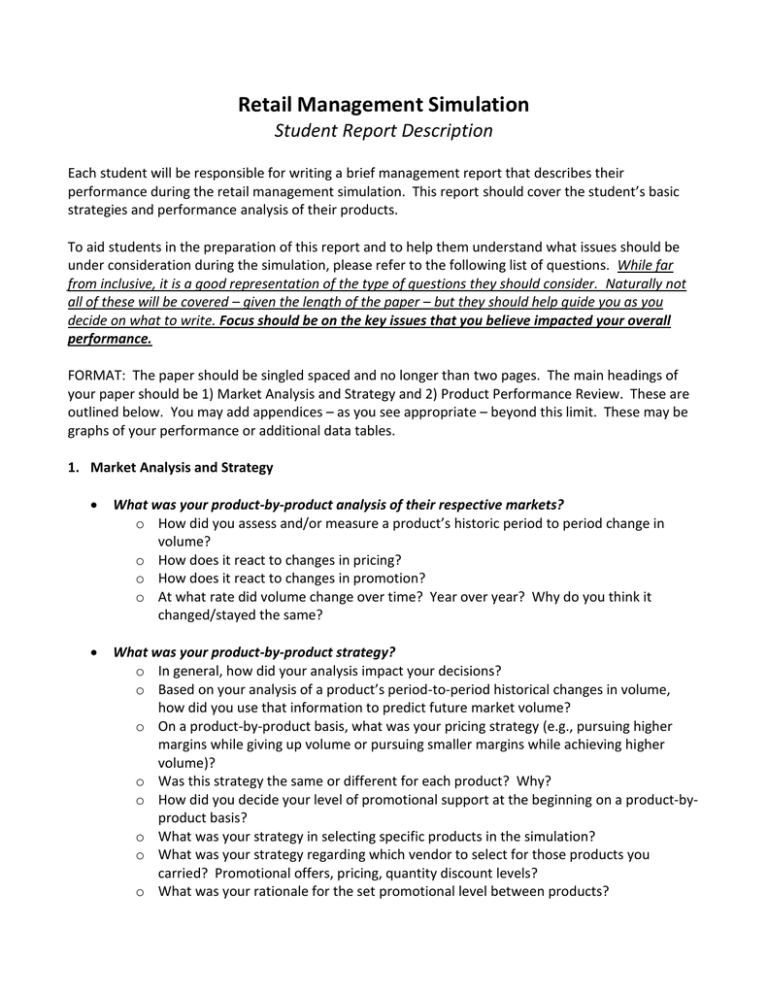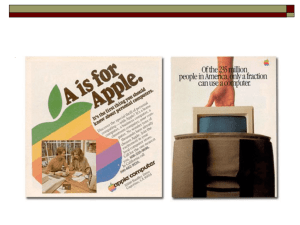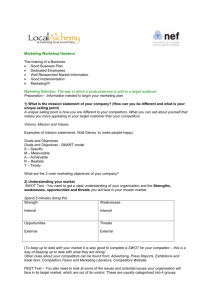Paper Instructions/Rubric
advertisement

Retail Management Simulation Student Report Description Each student will be responsible for writing a brief management report that describes their performance during the retail management simulation. This report should cover the student’s basic strategies and performance analysis of their products. To aid students in the preparation of this report and to help them understand what issues should be under consideration during the simulation, please refer to the following list of questions. While far from inclusive, it is a good representation of the type of questions they should consider. Naturally not all of these will be covered – given the length of the paper – but they should help guide you as you decide on what to write. Focus should be on the key issues that you believe impacted your overall performance. FORMAT: The paper should be singled spaced and no longer than two pages. The main headings of your paper should be 1) Market Analysis and Strategy and 2) Product Performance Review. These are outlined below. You may add appendices – as you see appropriate – beyond this limit. These may be graphs of your performance or additional data tables. 1. Market Analysis and Strategy What was your product-by-product analysis of their respective markets? o How did you assess and/or measure a product’s historic period to period change in volume? o How does it react to changes in pricing? o How does it react to changes in promotion? o At what rate did volume change over time? Year over year? Why do you think it changed/stayed the same? What was your product-by-product strategy? o In general, how did your analysis impact your decisions? o Based on your analysis of a product’s period-to-period historical changes in volume, how did you use that information to predict future market volume? o On a product-by-product basis, what was your pricing strategy (e.g., pursuing higher margins while giving up volume or pursuing smaller margins while achieving higher volume)? o Was this strategy the same or different for each product? Why? o How did you decide your level of promotional support at the beginning on a product-byproduct basis? o What was your strategy in selecting specific products in the simulation? o What was your strategy regarding which vendor to select for those products you carried? Promotional offers, pricing, quantity discount levels? o What was your rationale for the set promotional level between products? o What information formed the basis of your purchase volume and timing strategies for each product at the outset of the simulation? o What specific steps did you use to estimate the potential profitability of products and the impact of your various strategies (e.g., pricing, promotion, purchasing) on the profitability? 2. Product Performance Review What was your product-by-product analysis of your individual product and total results? o What factors – be that your company’s decisions or competitive decisions – impacted your product-by-product results? By how much? Why? o How did your key metrics (e.g., return on assets, gross margin return on inventory [GMROI], sales, inventory utilization, gross profit, net profit) change from period-toperiod? o What should you have known or better anticipated given what you knew after each decision? o What were the key impacts on your period-by-period and total return on assets (e.g., changes in inventory turnover, gross margins, operating expenses?) o By how much did period-to-period revenue (comp sales) change by product? What were the key impacts on your sales changes? o What factors impacted your product-by-product gross profit margins and total gross profits and by how much? o What impacted individual gross margins, net margins and gross margin return on inventory (GMROI) figures for each product after each decision? What analysis did you conduct regarding your competitors? o How would you describe your top competitors’ overall strategy based on what you know (e.g., pricing, market share) and what you can only estimate (e.g., promotional level and purchase volume)? o What impact did the analysis of your competitors have on your own strategies (e.g., changes to pricing, promotion, purchasing)? o What impact did your competitors’ pricing have on your sales? Can you quantify that impact? o How did you anticipate your competitors behaving going forward based on your analysis of their actions to date? o How do you specifically think your competitors’ would react to your actions to date? o In hindsight, how close were you to anticipating your competitors’ behavior? How did your strategy evolve during the simulated year? o Based on your analysis, what changes did you make to your pricing strategy on a goingforward basis? What was the rationale for these changes? What quantified estimate did you set for future sales based on this change? o Based on your analysis, what changes did you make to your product-by-product promotional allocation? How about changes to your corporate promotional allocation? o What changes in your inventory management did you make as a result of your past analysis and going-forward strategies? What formed the basis of these changes? o How did you quantify the impact of any of your strategic changes (e.g, change in pricing, change in promotional levels and allocation, change in purchasing behavior) on potential future results? Paper Rubric Writing Effectiveness Weight 7 Excellent (4 points) The writer’s decisions about focus, organization, style/tone, and content made reading a pleasurable experience. Writing could be used as a model of how to fulfill the assignment. The purpose and focus of the writing are clear to the reader and the organization and content achieve the purpose well. The writer’s analysis concerning initial strategic decisions is clear, concise and effectively presented. Decisions are based on clear understanding of market facts and indicate a strong logic. Good (3 points) The writer has made good decisions about focus, organization, style/tone, and content to communicate clearly and effectively. The purpose and focus of the writing are clear to the reader and the organization and content achieve the purpose well. Average (2 points) The writer’s decisions about focus, organization, style/tone, and/or content sometimes interfere with clear, effective communication. The purpose of the writing is not fully achieved. Poor (1 points) The writer’s decisions about focus, organization, style/tone, and/or content interfere with communication. The purpose of the writing is not achieved. The writer’s analysis concerning initial strategic decisions is generally clear and presented effectively. Decisions are based on a basic understanding of market facts and demonstrate an overall logical argument. The writer’s analysis concerning period-toperiod decision results is fairly well defined and presented effectively. Use of company, market and competitors’ data to support positions and going-forward decisions is provided and somewhat persuasive but is slightly incomplete. Report format is generally consistent. The writer’s analysis concerning initial strategic decisions is occasionally clear but is generally ineffectively presented. Decisions are marginally based on market facts with weak logic in the argument The writer’s analysis concerning initial strategic decisions is wholly unclear and presented poorly. There is no obvious logic to the decisions that are not based on presented facts about the market. The writer’s analysis concerning period-toperiod decision results is slightly unclear and is only marginally presented well. Use of company, market and competitors’ data to support positions and going-forward decisions is only marginally presented and is not overly persuasive. Many departures from required report format. The writer’s analysis concerning period-toperiod decision results is very unclear and presented ineffectively. Use of company, market and competitors’ data to support positions and going-forward decisions is largely absent and what is provided is not persuasive or relevant to decision-making process. Work fails to follow required report format. Minor errors. Minor errors. Several errors. Several errors. Numerous errors. Numerous errors. EXCEPTIONAL SATISFACTORY MINIMAL UNACCEPTABLE 120-95 points 94-70 points 69-45 points 44-0 points Analysis: Strategy 8 Analysis: Performance Review 8 The writer’s analysis concerning period-toperiod decision results is well-defined and presented very effectively. Use of company, market and competitors’ data to support position and going-forward decisions is comprehensive, logical and persuasive. Report Structure/Format 3 Spelling Grammar Overall Performance 2 2 Report format is consistent throughout including heading styles, fonts, margins, white space, etc. Negligible errors. Negligible errors. Total Points TOTAL






